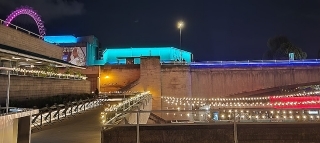Adam Yamey's Blog: YAMEY, page 15
May 14, 2025
After dark
May 13, 2025
If you are feeling peckish in Peckham …
GENERALLY, I AM NOT A FAN of food courts. Many of them in England are merely a collection of branches of well-known fast-food chains (such as KFC, McDonalds, Pizza Hut, Subway, and Burger King). A notable exception to this is a food court in Trinity Market in Hull, which visited in April 2025. On 9 May 2025, we visited Peckham in south London, having just viewed an exhibition in nearby Camberwell.
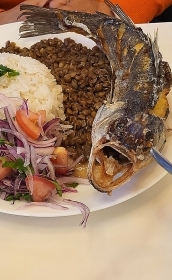
While strolling along Peckham’s busy Rye Lane, we came across the entrance to Rye Lane Market. After entering it and walking along an arcade lined with shops, we arrived in a large, covered area filled with food stalls: a food court. Unlike many other food courts, the food outlets were not branches of well-known chains. Instead, there were stalls catering to the multi-ethnic local population. We sat down at a table that was surrounded by stalls serving Mexican, Carribean, Colombian, and other many cuisines. We ordered the set lunch offered by a small Peruvian kitchen. As first courses, we ate cold boiled potatoes dressed in a red pepper flavoured mayonnaise and a delicately flavoured beef soup. These were followed by a fried rice dish containing chicken, pork, and smoked sausages, and another consisting of a whole fish beautifully fried, served with lentils, rice, and a salad containing onions, lime juice, coriander, and tomatoes. Freshly prepared and reasonably priced, everything was delicious.
There were more stalls serving food from other countries, mostly Latin American and African. One stall offered a range of vegetarian Indian dishes, including a snack, dabeli, that is popular in Kachchh (once an independent state, and now part of Gujarat). The lady working there told us that she is from Rajkot in Gujarat. When we mentioned to her that we have always thought that dabeli is a dish from Kachchh, she said it was Gujarati, but added that:
“It does not matter because the people of Kachchh are our brothers”.
Our first visit to Rye Lane Market’s food court has whet our appetites for further visits. There are so many enticing dishes on offer that I feel sure that we will venture across the Thames more often to sample the fare offered in that food court.
May 12, 2025
Between chance and control on sheets of paper
THE ARTIST BARBARA Nicholls (born 1963) invited us to the opening of her solo show at the Patrick Heide Contemporary Art gallery in Church Street, near Edgware Road. All her creations on display are watercolours on paper. Each of them resembles what looks like a natural phenomenon, but an imagined one. Although her pictures do not depict actual natural occurrences, each one of them is a result of the artist exploiting the unpredictability of the behaviour of the materials she is using at the same time as exerting some control over how they behave. To give some idea of what I am trying to say, here is something written in the notes issued by the gallery:
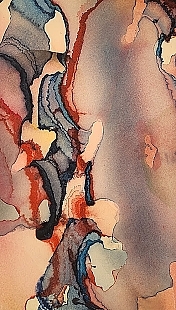
“Nicholls’ operations begin at times with large-scale sheets of heavyweight paper laid flat on the studio floor. The physicality of her practice is vital; she moves across and over the surface, first guiding water into pools or creating delicate lines with transparent washes. Once water touches the paper, it no longer remains flat, requiring Nicholls to carefully manage the buckling surface as she introduces pigment, experimenting with how much liquid the paper can handle. The drying process can be natural or carefully controlled through appliances like electric fans and heaters, which create microclimates that accelerate evaporation, allowing layers of colour to settle and crystallise over time.”
In other words, the artist chooses the places on the paper where the pigment and the water can be allowed to act as nature determines, and then lets them get on with it, producing whatever result the conditions permit. Thus, she covers the paper with a composition that is partly her choosing and partly the result of chemical and physical processes within the areas she has chosen for them to occur. The results are colourful abstract images, which are both beautiful and intriguing.
The exhibition continues until 21 June 2025.
May 11, 2025
A birth at Bethlehem seen through the eyes of a Ugandan
TO THOSE ACCUSTOMED to seeing European depictions of the birth of Jesus at Bethlehem, a picture currently (May 2025) on display at the SOAS Gallery in London’s Bloomsbury might come as a surprise.
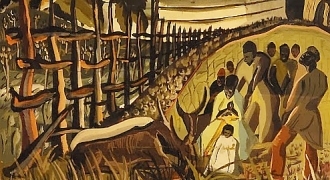
In 1958, the Ugandan artist Francis Musango (1932-2005) painted his “Birth of Christ”. Set in a luxuriant tropical landscape, everyone in the manger where Jesus is lying has a black African face. When I saw this painting yesterday, 8 May 2025, it was the first time I had seen a Nativity scene in which all the people are Africans. Jesus was born in what is now the Middle East, yet in many European depictions of this historic birth, the faces of the people in them have European rather than Semitic physiognomies. So, it is perhaps not so surprising that an African artist should have chosen to populate his Nativity scene with people who look African rather than Semitic.
Musango is not an artist whom I have come across before. So here is something about him on the SOAS website:
“Francis Musango trained as a teacher and also joined the religious order of ‘The Brothers of Christian Instruction’. In 1954 he gained a scholarship to the school of art at Makerere University, where he studied under Trowell’s tutelage. Subsequently he worked as an art educator in Kitovu and later as Inspector of Schools, Arts and Crafts (1970-77), promoting art in the Ugandan curriculum. He became a lecturer at the Makerere School of Art in 1977 and head of department from 1986 to 1988.”
May 10, 2025
An ingenious use of simple matchsticks in a work of art
FROM AFAR IT LOOKS like a small red and black oriental rug, but as you approach, it is not what it seemed at first sight. This artwork by Hadi Rahnaward, who was born in Afghanistan in 1986 and now resides in Belgium, is made with matches, glue, and other materials. The matches used are of two sorts. Some are tipped with black material, and the others with red.
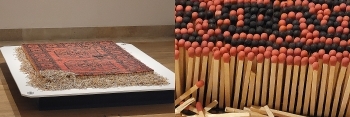
The matches have been glued to a base so that each one of them is vertical and standing with its tip pointing upwards. They have been placed close to each other in such a way that their tips form a mosaic resembling a patterned oriental carpet or rug. The artist made this incredibly intricate creation in 2023. It is one of a collection of often intriguing artworks by young artists from south Asia and Afghanistan being exhibited at the SOAS Gallery (formerly known as the ‘Brunei Gallery’) in London’s Bloomsbury until 21 June 2025.
One of the other exhibits that intrigued me is an embroidery by Varunika Saraf (born 1981), who lives and works in Hyderabad (India). Called “The Longest Revolution” and made in 2024, this embroidery depicts many features of Indian women’s struggle for basic rights and parity with men. This busy looking artwork depicts many aspects of women’s political struggles, and in places reminds the viewer of some parts of the Indian Constitution that appear to have been considered less relevant than previously by some in India during the last few years. Even if the political content of this piece is ignored, it is an eye-catching work of art.
May 9, 2025
Superb sculptures at a gallery in South London
HE WAS BORN in Chicago (Illinois) in 1935 and as a child was often taken by his mother to public galleries in the city. Maybe at least partly because of this Richard Hunt, who died in December 2023, became an artist. In 1953, he was awarded a scholarship to study at School of the Art Institute of Chicago. It was there that his interest in working with metal began and that he became acquainted with the work of the leading modernist artists of the 20th century. He taugh himself welding, and many of his fascinating sculptures that are on display at the White Cube Gallery in Bermondsey (until 29 June 2025) can be seen, beautifully displayed.
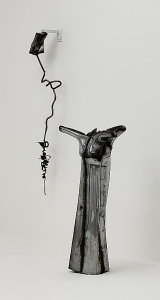
Many of the sculptures consist of bits of waste metal that Hunt salvaged, modified, polished, and welded together. Other sculptures are made of cast metal. Many of Hunt’s works are abstract, but suggest to the viewer that they might also depict transformations of organic forms. Each of the sculptures is intriguing and original. The influences of other artists might be subtly evident in some of them, but they are not at all obvious. The gallery’s website noted:
“Hunt developed a sculptural language that was both deeply personal and richly associative, drawing on a broad array of influences: the forms and rhythms of the natural world; the mythic narratives of Greek and Roman antiquity; his cultural heritage and global travels; the formal vocabulary of European modernism and the legacy of African American civil rights leaders who shaped his time.”
As one looks at the works on display, many of the things in the quote above become apparent.
Although some of the works at White Cube are quite small, Hunt has produced many huge works – too large to be within the White Cube – that are displayed in public places. I thought that Hunt’s sculptures were wonderful, and was surprided that until visiting this show I had not been aware of his work. The show at the White Cube was quite a wonderful eye-opener for me and I can strongly recommend seeing it.
May 8, 2025
Dali and Dante in London’s Bermondsey Street
EAMES FINE ART Gallery is in south London’s Bermondsey Street. It specialises in original prints and paintings by Modern and contemporary masters. Whenever we are in Bermondsey Street (usually to visit the White Cube Gallery and the wonderful Vietnamese eatery called Caphe House), we take a look at what is being shown at Eames. Until 18 May 2025, they are showing a collection of wood engravings that the surrealist artist Salvador Dali (1904-1989) first created as watercolours before supervising their transfer onto woodblocks to make prints based on these paintings.
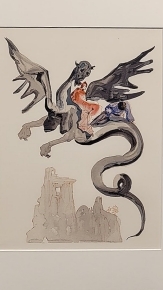
In 1950, the Italian government commissioned Dali to produce a set of images to illustrate the “Divine Comedy”, which was composed by Dante Aligheri (c1265-1321) between about 1308 and 1321 AD. Dante’s work is one of the treasures of Italian literature, and the commissioning of Dali, who was not an Italian, was so controversial that it was debated in the Italian Parliament, after which Dali’s contract was cancelled. As the gallery’s website notes:
“Undeterred, Dalí, with the help of the French publisher Joseph Forêt, decided to complete the project himself and produced 100 sumptuous watercolours in a searing evocation of Heaven, Hell and Purgatory in response to Dante’s text..”
It was these watercolours that were transformed, under Dali’s supervision, into the prints, which are currently on display at Eames. I was interested to see them because usually the only works by Dali that I have seen have been his oil paintings. The images that have been created from these watercolours by Dali are more impressionistic and freer in form than the almost crystal clarity of the images in his oil paintings. I am pleased that we took a look inside Eames. We had no idea that they were showing such an interesting collection of works.
May 7, 2025
Marilyn, Mao, and more at Milton Keynes
ONCE AGAIN, THE MK Gallery at Milton Keynes has put on a superb exhibition. Until 29 June 2025, there is a show of artworks by the artist and film maker Andy Warhol (1928-1987), who was born in the USA. Best known for his multiple portraits of figures such as Marilyn Monroe and Mao Tse Tung and Pop Art images, there is much more than this on display at the MK.
The first room of the show contains work that Warhol created in the 1950s and early 1960s. Like artists such as Picasso and Hockney, whose creative lives began with works that were not as experimental and novel as their later works, Warhol’s earlier, less revolutionary, images show that he was a competent draughtsman capable of producing highly acceptable ‘straightforward’ compositions. It was interesting to see his earlier works because they are rarely displayed in public galleries. And it is always nice to see how an artist who is best known for his or her more extraordinary creations began his or her creative output.

The exhibition includes many of Warhol’s Pop Art images including those of Marilyn and Mao, but also there are several of his portraits of other figures. These include the artist Basquiat, the politician Barry Goldwater, Marcel Duchamp, Joseph Beuys, Muhammad Ali, and Liz Taylor. What I found interesting was that amongst the portraits on display, there were a few of the British artistic couple Gilbert and George. As the exhibition booklet related:
“The British artistic duo Gilbert and George , like Warhol, explored the interplay between personal and public identity, often blurring the lines between performance and art.”
Warhol’s portraits of this couple reflect their own graphic artistic style.
Other images on display relate to the Cold War and to the electric chair. The images on display in the show include drawings, prints, posters, and photographs (often adjusted to create interesting artistic effects). There are also exhibits relating to Warhol’s prolific output of films. He made about 600 of them. It would have been interesting to have been able to see extracts from some of them.
In brief, this is an exhibition that is worth travelling to. Apart from being beautifully displayed alongside helpful information panels, it is worthy of a visit to be able to enjoy seeing this artist’s rarely seen early works.
May 6, 2025
Poor spelling
May 5, 2025
An artist from Aberdeen in west London
SURROUNDED BY SOCIAL housing, the Frestonian Gallery is within a stone’s throw from the Westfield shopping mall in west London’s Shepherds Bush. This small but elegant commercial gallery hosts well-chosen artworks at temporary exhibitions. The artists whose works are displayed there are not as well-known as those shown in some of the larger and longer established galleries in Mayfair, but all of them deserve to be recognised as worthy exponents of their craft and creativity.
The current exhibition, which continues until 13 June 2025, is of paintings by Barry McGlashan, who was born in Aberdeen (Scotland) in 1974. Trained in painting at Gray’s School of Art in Aberdeen, he went on to teach in its painting department between 1998 and 2005. He now lives and works in Edinburgh.
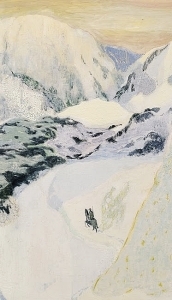
At first glance, many of Barry’s paintings have a hazy or misty appearance. After a few moments, the mist seems to clear, and the viewer can enjoy beautifully painted scenes. The paintings have a dream-like quality, and as the gallery’s handout notes, some of his images are:
“… at once so vivid and yet close to slipping away entirely …”
Barry refers to a concept embraced by the Elizabethan John Dee (1527-1608). Namely, that the world around us is far more unseen than seen. Barry’s pictures do depict such an idea very well.
Rather than wasting time and money in the Westfield shopping mall, feed your eyes on the lovely paintings currently on show at the Frestonian. You will not regret visiting this gallery.
Address: 2 Olaf St, London W11 4BE

